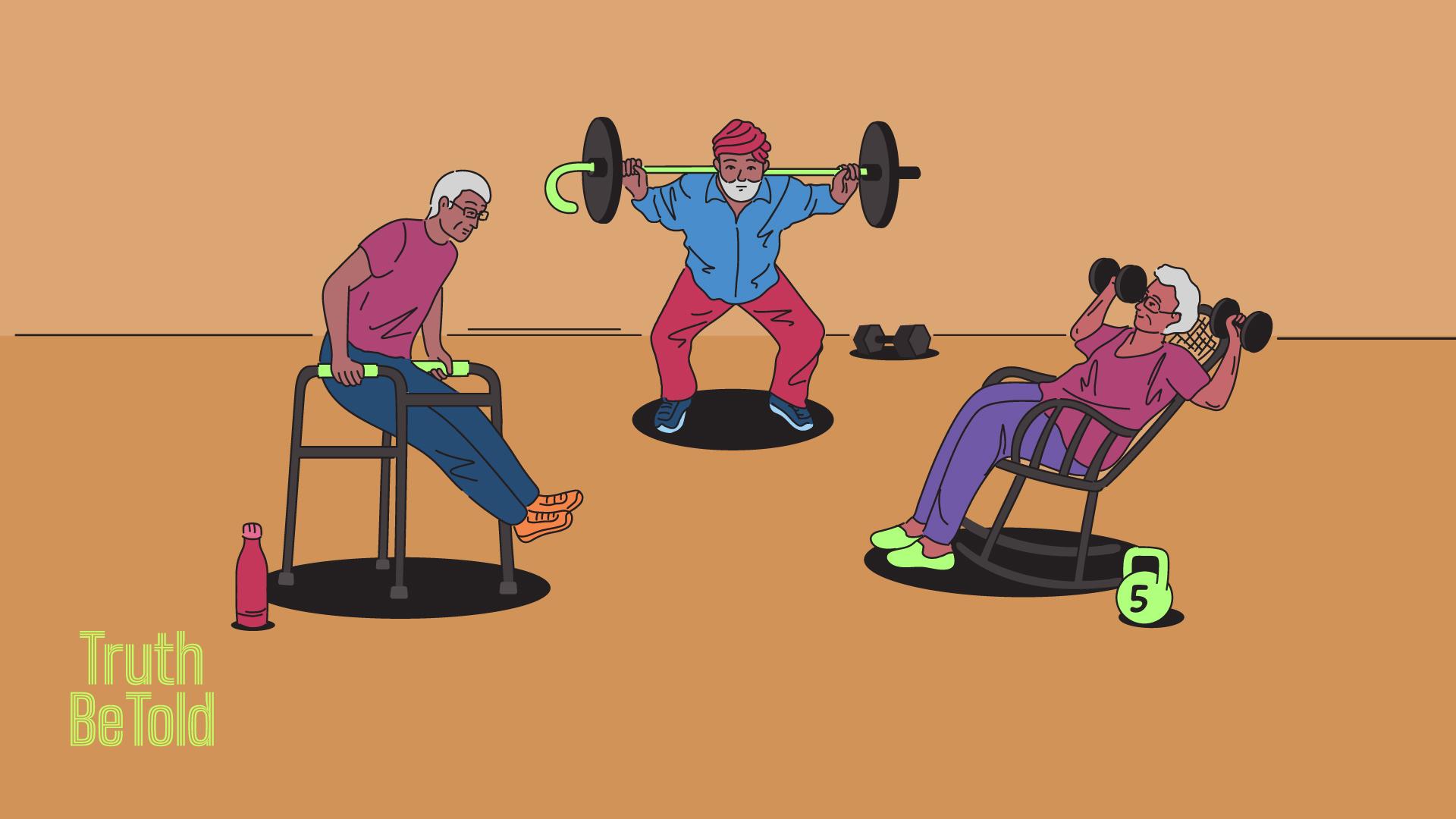How my dad started strength training at 63
And why you should too
The most trustworthy source of food and
fitness journalism in the country.
Editor’s Note: In today’s issue, Ankush Datar, an investment management professional, makes a case for strength training and lifting weights by sharing the heartwarming story of his 63-year-old dad, Ajit Datar.
His dad went from struggling to bend down to pick things up to boasting a straighter posture, wider shoulders, and a slimmer waistline. Ajit uncle’s story is a testament to the incredible benefits of strength training, which Ankush explains in this piece, and I hope it will leave you motivated to hit the gym for a healthier and stronger you!
My father, Ajit Datar, a 63-year-old diabetic and heart patient. He joined the gym for the first time in February 2022. It’s been one year. And I am amazed by what he has achieved.
Just look at his progress.
That’s him on day one: he could barely squat, he couldn’t sit cross-legged, and he had never worked out in the gym in his 63 years of existence.

Now look at day thirty: he progressed slowly, getting there with freehand full-range squats.
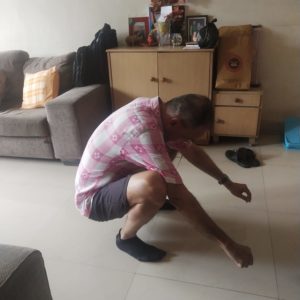
And this is today: easily pulls off barbell squats and can now sit cross-legged.
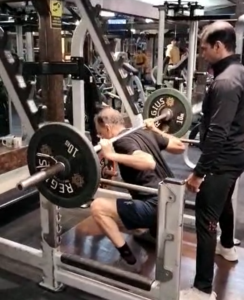
Amazing. Isn’t it?
He’s now set a target of being able to do a pistol squat by the end of 2023 and deadlift 1.5x bodyweight.
So why am I telling you this? Because I think there are lessons to learn.
Start with his backstory.
My dad is a chartered accountant — a partner at his own firm. In his sixties, all was not well. A type 2 diabetic with a bypass surgery under his belt, he knew he had to change his ways before it was too late. Yet, like many of us, he struggled to make it happen.
As the world went into lockdown, his motivation plummeted. Stuck indoors, he found it difficult to muster the energy to exercise. No matter how much I nagged him, he couldn’t find the drive to get moving.
But one fateful day, everything changed. As he boarded a flight for a much-needed getaway, he struggled to lift his suitcase into the overhead compartment. A kind young man offered to help, and something inside him snapped at that moment.

He realised he couldn’t go on like this — he couldn’t bear the thought of spending his golden years in a state of physical weakness.
And so he made a vow to himself: he would do whatever it took to get strong and healthy. The road ahead would be tough, but he was ready to face it head-on. No more excuses. No more hesitation. It was time to take back control of his life.
In his sixties. Better late than never.
Since February 2022, he’s been on a roll! He took my advice and hired a personal trainer without even seeing the gym, showing his serious commitment. He’s now unstoppable, entirely devoted to improving himself. It’s contagious, really.
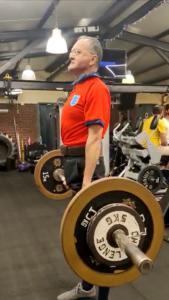
Witnessing his progress is a true inspiration, proving that we can always regain strength and mobility if we set our minds to it.
My dad is living proof that strength training can be a game-changer: it’s not just about looking ripped, it’s about slowing the ageing process. As we get older, we lose muscle mass and that can bring on all sorts of health issues. But with strength training, we can keep our bodies healthy and functional even when we’re pushing on in years!
Narici and Maffulli have reviewed how, back in the 4th and 5th centuries BC, the Greeks viewed ageing as an incurable disease. But attitudes towards ageing began to shift by the 1st century BC and 1st century AD.
The great Roman statesman Cicero believed that ageing was a modifiable condition that could be fought against like a disease. In his ‘Essay on Old Age’ published in 44 BC, he wrote that “it is our duty to resist old age, to compensate for its defects, to adopt a regimen of health; to practise moderate exercise; and to take just enough food and drink to restore our strength.”
As we age, it’s crucial to remember Cicero’s words and fight against the effects of ageing through a healthy lifestyle.
And that’s the point of this piece: making a case for you to add strength training to your routine.
It’s for everyone, like my dad.
Like what you see so far?
Get TBT articles in your inbox every Saturday
Why strength training?
Strength training is about building muscle mass, improving physical performance, and boosting overall health. You don’t necessarily have to use weight machines: you can achieve this through free weights, resistance bands, or even body weight.
The key is challenging your muscles to work against resistance and grow stronger.
It’s not exactly glamorous. It’s actually very boring.
The fitness industry can be overwhelming, especially with the constant barrage of unrealistic body standards on social media. But let’s face it: that celebrity with the perfect six-pack you follow on Instagram isn’t getting there with a 30-day challenge. Instead, they’re hitting the weights and putting in the work day after day, week after week.
Unfortunately, strength training often gets a bad rap with common misconceptions that keep people from trying it. One of the biggest ones is that strength training is only for bodybuilders or those looking to become bulky. Nope, that’s not true. Again, it’s for everyone, regardless of age, gender or fitness level.

Another myth is that strength training will make you bulky and turn you into a hulk-like figure. Again, not true.
Let me break it down for you in simpler terms: Why does strength training matter?
First, it can also help you burn calories even after you’re done working out.
When you lift weights and build muscle, your body has to work harder to maintain and repair that muscle, which means it burns more energy even at rest. That’s why people with more muscle mass tend to have higher metabolisms and can eat more without gaining weight.
Muscle is an expensive tissue: it makes up about a third of your body mass and requires about a fifth of your energy budget. That’s why people with more muscle tend to burn more calories even when not doing anything.
So if you compare an 80kg person with a lot of muscle to an 80kg person with more fat, you might think the muscular person weighs more since muscle is denser than fat. But in reality, the muscular person will burn more calories all day, even when sitting on the couch.
Second, it has many health benefits that can help you age more gracefully.
For example, building muscle can help prevent diseases as you age since muscle plays a crucial role in vital bodily functions and protein synthesis in vital tissue and organs.
Studies have shown that just ten weeks of strength training can help increase lean muscle mass, reduce body fat, and increase resting metabolic rate in inactive individuals.
Third, it can also help reduce the weakening of bones, which increases the risk of fractures and injuries from falls as we age. Lifting weights can help improve bone density and strength. This is especially important for people with osteoporosis, who may be at risk of fractures from even minor falls.
Does it make sense? Convinced? I hope so — now drop and give me five pushups. (Just kidding, I’ll spare you this time.)
Like what you see so far?
Get TBT articles in your inbox every Saturday
But don’t get this article wrong: cardio is important too.
Cardio is also important in maintaining efficient heart health. It can complement your strength training regime. And it can be in any form you find comfortable: running, swimming, HIIT, dancing or any other such activity. Research suggests that combining cardio and strength training efficiently in one’s routine leads to a longer life.
All I am trying to say is that only cardio or following that Instagram reel is not going to get you results that sustain you over the long term.
***
It’s all about the process
Now let’s face it, we all want immediate results. We’re so focused on achieving the goals that we often forget about the journey that gets us there.
That’s where the saying “process over the outcome” comes in. It may sound cliche, but it’s the truth regarding health pursuits.
And the key to the strength training process? Progressive overload.
Progressive overload is the secret sauce that makes your muscles grow and increases strength. The idea is simple: add just one more rep or notch up the weight just a bit each time you hit the gym. Compounding will take care of the rest over the long term.
Need proof? Look no further than the legendary Milo of Croton, who was reputed to carry a bull on his shoulders.
This Roman wrestler and strong man didn’t get his strength from lifting heavy weights all at once. He started small by lifting a newborn calf on his shoulders. And every day, he did it again. And again. For four years, he carried that calf until it grew into a full-grown bull. That’s the power of progressive overload.
My dad has a brilliant trick that has made all the difference in his workouts to enable progressive overload: 0.5 kg dumbbell plates.
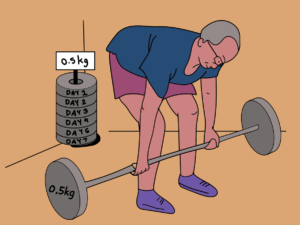
These tiny weights may seem insignificant but are crucial in aiding progression, especially when you hit the heavy weight category, where the increase in reps and weights slows down. (Plus, they keep your ego in check — because, let’s be honest, who doesn’t like adding more weight to their lifts?)
Few other things:
One: If you’re serious about progressing in your fitness journey, you need to keep track of your lifts and reps. Making notes from your previous session is the only way to strengthen progressively.
Two: Drop your ego and focus on the form of your sets to ensure maximum muscle gain which comes from contracting the muscle completely to failure.
Third: Make a schedule to ensure you know what you must do once you arrive at the gym.
Here is my dad’s schedule.
Monday – Push Day
Tuesday – Stretching + Walking
Wednesday – Leg Day
Thursday – Free Weights
Friday – Pull Day
Saturday – Stretching + mobility at home
Sunday – Brisk Walk
Of course, you can — and you should — customise it to your preference. And remember, you don’t need to work out more than four days a week. Just make sure at least two days are devoted to strength training.
Fourth: And lastly, as cliche as it may sound, showing up is the most challenging part of the process. 90% of the work is only showing up because once you’re at the gym, you’ll be motivated to get your workout in.
My dad keeps a calendar in his room and ticks off each day that he exercises — a simple yet powerful technique to hold yourself accountable.

I am very proud of what my dad has done for himself. I take inspiration from him daily — and I hope it helps you somehow.
And if so, you should now drop and give me five pushups! 🙂
Click the logo to sign up for the newsletter
